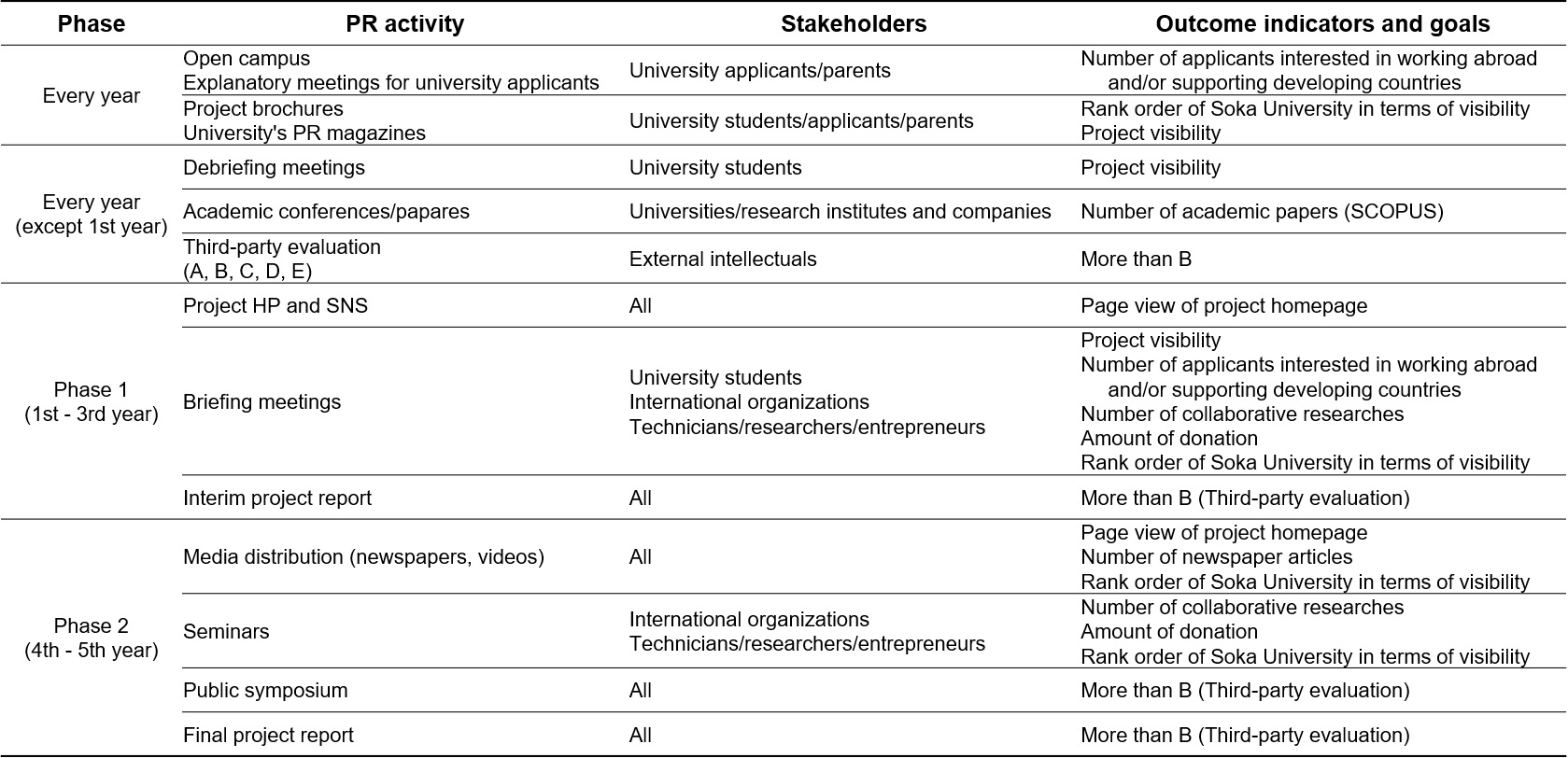- Research
- Private University Research Branding Project
- Branding Strategies
Branding Strategies
A. University’s future vision, project’s originality, and current situation
[University’s future vision]
According to “Soka University Grand Design”, university’s future vision is to foster “creative individuals”, who contribute to society based on university's founding principles. In the diploma policy of Soka University Grand Design, creative individuals are defined as human resources who have the following four skills: intellectual foundation (broad knowledge and advanced expertise), practical ability (ability to apply knowledge to society and communication skills), internationality (ability to accept diversity and cooperate with others), and creativity (ability to integrate and creative thinking).
[Project’s originality]
Project’s originality is to propose "Plankton Eco-engineering" as a new research field by integrating sciences and liberal arts in order to contribute to environmental conservation and the elimination of hunger in developing countries through constructing sustainable recycling society. Plankton Eco-engineering is referred to as an interdisciplinary engineering to enrich human society through environmental restoration, biomass production and commercialization, and the suggestion of business models utilizing the function of plankton in a natural environment.
[Current situation]
University’s future vision is informed to all faculty members every year by explaining Soka University Grand Design and promoting opinion exchange. The contents of Soka University Grand Design is informed to all people both inside and outside of university using university homepage and brochures.
This project is considered by the Research Promotion Center, which is led by university president, discussed and approved by university administrative board and educational/research council, and informed to all faculty members.
B. Stakeholders
The stakeholders of this project are undergraduate/graduate students, international organizations such as United Nations (UN) and non-governmental organizations (NGO), and students, technicians/researchers/entrepreneurs, universities/research institutes, and companies in developing countries (Fig. 2). Further, university applicants/parents, Japanese companies, and universities/research institutes can also be considered as stakeholders.
C. Expected image of Soka University
[University students/applicants/parents and Japanese companies]
By participating in an interdisciplinary project and receiving practical international education, students become interested in international careers. As a result, students are expected to get a job with multinational/foreign companies and international organizations. Further, Japanese companies are interested in environmental conservation and the elimination of hunger in developing countries in recent years to fulfill corporate social responsibility (CSR). The suggestion of bottom-of-the-pyramid (BOP) business and the activity of graduates involved in this project will be attractive to Japanese companies. Thus, Soka University will be recognized as a university producing human resources who contribute to international society.
[International organizations]
This project addresses environmental conservation and the elimination of hunger, which are listed in sustainable development goals (SDGs) suggested by the UN. Thus, Soka University will be recognized as a university leading humanitarian support for the poor.
[Students, technicians/researchers/entrepreneurs, universities/research institutes, and companies in developing countries]
In this project, people in developing countries receive environmental and economic education through training programs at Soka University and local workshops held with international organizations. Thus, Soka University will be recognized as a university supporting developing countries.
[Japanese universities/research institutes]
By presenting the results of this project in academic conferences and papers, Soka University will be recognized as a university specialized in the development of environmental technology and the planning of business models.

D. Current image of Soka University
E. Information dispatch
The expected image of Soka University described above will be widely spread by rapidly and accurately sending information on the contents and results of this project to each stakeholder using the following methods:
[For all stakeholders]
- Project homepage and social networking services (SNS) such as Facebook
- Media distribution (newspapers, magazines, and videos)
- Public symposium
[For university students/applicants/parents]
- Briefing and debriefing meetings
- Project brochures and university’s PR magazines (SUN)
- Open campus and explanatory meetings for university applicants
F. Branding processes
The details of branding strategies in each year are shown in Table 1.
[For effective information dispatch]
The Project Management Committee in the Research Administration Center plans branding strategies (“Plan”). The Publicity Committee and faculties/graduate schools send information on the contents and results of this project (“Do”). The Project Management Committee evaluates these activities (“Check”) and modifies branding strategies (“Act”).
[For clarification of university’s strengths and differentiation from other universities]
The Project Management Committee in the Research Administration Center plans branding strategies (“Plan”). The Publicity Committee and faculties/graduate schools conduct promotion activities (“Do”). The Project Management Committee evaluates these activities (“Check”) and modifies branding strategies (“Act”).
G. Outcome indicators and goals
[For effective information dispatch]
- Page view of project homepage: 20% increase compared with the 1st year
- Number of newspaper articles: 20% increase compared with the 1st year
- Number of academic papers (SCOPUS): 20% increase compared with the 1st year
[For clarification of university’s strengths and differentiation from other universities]
- Number of applicants interested in working abroad and/or supporting developing countries: 20% increase compared with the 1st year
- Number of collaborative researches: 20% increase compared with the 1st year
- Amount of donation: 20% increase compared with the 1st year
- Rank order of Soka University in terms of visibility: 20% increase compared with the 1st year
- Project visibility: 20% increase compared with the 1st year
- Third-party evaluation of this project (A, B, C, D, E): More than B
H. Progress management of outcome indicators and goals
The Publicity Committee in the Research Administration Center gathers information on the results of each PR activity. The Publicity Committee regularly discusses and establishes future plans.
